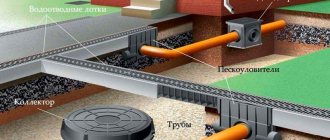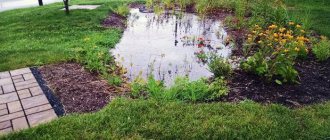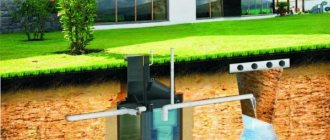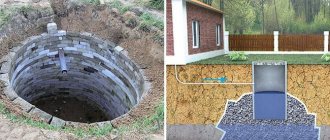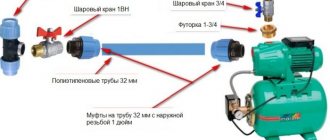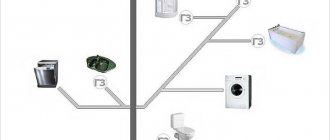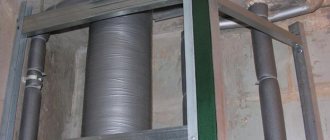To prevent a flood in the area after any rain, to protect the foundation from moisture, which can lead to its destruction, you need to create a reliable drainage of snow and rain moisture. Rainwater drainage will help with this - a system for receiving and removing water through special channels. In your home, the storm drain is small, but it works the same as a similar system on city streets.
What is a storm drain in a private house?
In places where there is a lot of rainfall, rainwater must be drained. Without this, the soil in the yard becomes limp and remains wet for a long time, gradually destroying the covering of garden paths. Storm drainage on a personal plot is the key to the long service life of a residential building and order in the yard. This type of engineering systems is called differently - rainwater drainage or stormwater drainage.
The storm sewer system necessarily contains the following elements:
- House drainage system. These are gutters installed along the roof; precipitation from the roof flows into them. They fall into funnels and then flow down drainpipes;
- Several water receivers on the soil surface (reception funnels, linear drainage systems). They are placed so that all precipitation gets there and moisture does not spread throughout the area. Point receivers are mainly located under drainpipes; it is advisable to install receivers on asphalt and concrete-filled areas, in places covered with paving slabs. Install linear receivers near garden paths; water will flow into them well if the covering is laid on a slope;
- Sediment discharge and storage system.
Storm drains can serve as a source of water for irrigation of the site. It is only necessary to place the system pipes into a container of a suitable size, and pump water from it into the irrigation system. If you have nothing to water, you can direct the water to a nearby pond, sewer system or drain. If this cannot be done, create a drainage field by preparing perforated pipes and digging them into the soil.
There are 3 types of storm drainage:
- Underground system. All elements are buried in the soil. Outwardly, such a structure is invisible, but it will require a lot of ground work and spend a lot of money. It is most convenient to create this system when redeveloping a site or during the construction of a residential building. There are 2 types of underground stormwater systems - non-freezing and freezing. For non-freezing storm drains, it is necessary to bury the pipes below the soil freezing level, in central Russia - 150-170 cm. The freezing system does not work in early spring and winter, but they are easier to make; you need to dig the pipes to a depth of about 30 cm;
- Above ground system. These are drainage gutters through which incoming water goes into the garden or enters a container;
- Mixed system. In this case, some of the pipes are laid in the soil, and the rest are placed on the surface. This is the best option in terms of appearance and cost.
Each system is designed depending on the site; there is no one recipe. Any territory has its own characteristics - how well the soil absorbs water, layout and topography, existing buildings.
Types of drainage, their features and purpose
There are 2 types of drainage around a low-rise building: surface and underground; let’s look at both types:
Surface
Surface drainage and point storm drains around the house are built to collect excess moisture that falls in the form of precipitation. According to the layout of drainage pipes (drains), this type of system is divided into ring, layer, and wall.
For each specific case, a separate project is created, which takes into account the landscape, soil type, location of buildings on the site (existing or future), type of foundation of permanent buildings, level of soil freezing and many other points.
Type 1. Wall
The drainage around the winding is of the linear variety. Be built simultaneously with the foundation. Construction of the system after completion of construction is possible, but it is much more difficult and expensive.
Necessary for removing moisture from the external surfaces of the foundation. It consists of trenches encircling the foundation along the perimeter at the maximum permissible distance, in which drains are laid. The depth of the trench is 0.3-0.5 m below the foundation level.
The trenches have a slope, usually 1 cm -2 cm per 1 m, so that water flows under the influence of gravity to one lower point.
At the lowest point, the drains are connected to the inspection well. An outlet pipe is also connected to it.
Type 2. Layered
A complex, expensive and at the same time very effective way to prevent the destructive effects of water on the foundation. It is used to drain the soil under the foundation and communications when:
— a permanent structure is planned to be built directly above the groundwater lens;
— the site is located on an aquifer;
— groundwater comes to the surface under pressure;
— other methods of protection are not effective.
The plot of land is not drained in this way due to economic infeasibility.
Reservoir drainage is constructed under the foundation and connected to a wall or ring drainage system. This bond effectively removes moisture.
It is a sand cushion with a thickness of 0.3 m with prisms made of gravel or crushed stone, which are placed at a certain pitch. Also, the sand cushion can be covered with a continuous layer of gravel/crushed stone. The latter option is used when enhanced water drainage is required. The perimeter of the sand layer is made larger than the perimeter of the foundation.
The top of the drying pad is covered with perlite. Perlite prevents concrete from leaking into the gravel or crushed stone layer when pouring the foundation, maintaining its drainage properties.
Type 3. Circular
To be built to lower the groundwater level. Unlike stratum, it is used to protect the foundation from water and drain the land.
To protect the house, a ring system is laid around it at a set distance. The distance to the drains is maintained at least 5 m to prevent soil shrinkage. If necessary, strengthen the soil. The drainage depth around the house is 50 cm ± 20 cm.
To drain the site, a project is being developed that matches the topography and location of the buildings.
The principle of this drainage device around the house is similar to the construction of a wall system.
The advantage of the ring type is that it can be erected when the construction of the house is completed. Also, the ring system can be combined with wall and layer ones.
Underground (deep)
They build deep drainage around the house on clay soils when the construction of a surface system is impossible or impractical. It is a complex, sometimes multi-level system. They are built on watery lands, in lowlands and in areas located in floodplains and near floodplains.
For private houses, 3 types of underground drainage systems are relevant: horizontal, vertical, combined.
View 4. Horizontal
Consists of drains, inspection wells, and catch basins. You also need a pump to pump out water.
The principle of laying drains for an underground horizontal system is similar to laying surface linear drainage. At corner joints and at the lowest point, drains are connected to inspection wells. This is necessary in order to notice and clean up dirt in time.
Water flows through drains into reservoirs. From there it partially goes into the underlying layers of soil. The water that remains in the reservoir is pumped out with a pump for irrigation or other household needs.
Similar to surface drainage, horizontal deep drainage can be implemented in the form of a ring, wall and layer structure. The latter differs from the layered surface one in that instead of a drainage cushion under the foundation, an artificial reservoir is created, filled with gravel or crushed stone with a depth of 0.3 m. The water from it goes into the soil or into another part of the drainage system.
View 5. Vertical
It consists of water intake wells and reduction wells, with a depth of 20 to 50 meters and a pump. From the wells, a certain amount of water goes into the soil, the excess is pumped out with a pump.
Type 6. Combined
Combines the design of vertical and horizontal drainage.
On topic: Site drainage in 5 steps: how to do it yourself
Combined or separate system
In a private house, storm drainage can be open, point and mixed. Each of them has its own purpose, and they differ in design.
Open sewer
This design is effective and easy to manufacture. The system is manufactured as a network of plastic, concrete or steel gutters placed on the soil surface. With their help, water from drainpipes enters a special container or general sewer system. The gutters must be covered on top with special decorative grilles to prevent debris from getting into them. The gutter parts are connected and treated with sealant. This type of storm drain is capable of collecting moisture from a very large area; water can be directed into it not only from the roof of a residential building, but also from various areas, sidewalks and garden paths.
Recommendation! When installing an open storm drain, do not forget about the slope of the installed gutters, otherwise the water will not drain well.
Point sewerage
When using point storm drainage in a private house, all pipelines must be placed below the ground surface. Water coming from the roofs flows into rainwater inlets protected by decorative gratings, and from them enters an underground pipeline. Along them, she goes to gathering places, or beyond the boundaries of the personal territory.
Recommendation! Underground communications are physically difficult to install in the soil; it is best to arrange it during the construction of a residential building. Once the garden area is built up, this work will become difficult to complete.
Mixed storm sewer
These systems are used when there is a desire to reduce labor and money costs. It can use elements of any storm drainage system.
Often different sewer systems are located on a site nearby or located in parallel, so there is a desire to save money and combine different systems. For example, connect all systems to an existing well. We must warn you that you shouldn’t do this; when there is heavy rain, a lot of water flows into the well - about 10 m2 per hour, and it will fill up very quickly, sometimes the water even begins to overflow. If the sewer from the house is connected to it, then the water will flow into the sewer pipes, as a result, your drains will not leave your plumbing fixtures. When the water level in the well drops, a lot of debris will remain inside, it will have to be cleaned, otherwise the sewage system from the house will not be able to work normally.
When rainwater enters the drainage well, everything will be even worse. During a rainstorm, rainwater enters the system, all the pipes will fill, and it will begin to flow under the foundation. The consequences will not please you; in addition, silting of the drainage will occur. It is impossible to clean this system, and replacing the pipes will require spending a lot of money.
There is only one conclusion - for storm drainage you must make your own capacious well.
Types of rain systems and their design
There are three main types and methods of organizing a drainage system for collecting rainwater:
- Open.
- Closed.
- Mixed.
The first option is the simplest and most inexpensive way to arrange a storm drain. This refers to a system of installed gutters on the roof. Water is collected through them. Then the drainage is carried out through semi-open special grooves.
Storm sewerage in a private house, design diagram
The system has all the devices; if necessary and depending on the site, you can design a sewer system of any complexity and configuration.
All elements create a system, it should include:
- Well. It should have the maximum possible volume. The size directly depends on the possible amount of rainwater, the dimensions of the site and the roof. It is convenient to make it from concrete rings. They are dug into the soil, and a slab with a hatch is made above the well. If you take a concrete slab with a hatch, you can pour 4-5 cm thick soil on top and plant lawn grass. The lawn growing above the well will be slightly different in density and color; if you add a layer of earth of 15-20 cm, you will not notice the difference;
- Well hatch. These elements are made from different materials - steel, cast iron, plastic or rubber, and are chosen only taking into account the personal preferences of the owner of the house. It doesn’t matter what you make the well from, it should be at such a depth that its top cut is 15-20 cm below the soil surface. To install a hatch, a small neck is often made of brick; this will allow you to grow a lawn that will not differ from the rest of the territory;
- Point water intakes. The containers are small in size; they are placed in places where water accumulates - in low areas of sites, under drains. They are made of concrete or plastic. Concrete products are used to create deep storm drains. They are installed vertically one on one, to the required height. Now they have started selling built-on plastic water inlets;
- Drainage channels. Concrete or plastic gutters are placed in places where a lot of rainwater collects - near garden paths, along roof overhangs, if there are no gutters. Sometimes they are installed under gutters; this is convenient if, when making a blind area near a residential building, they did not provide for the laying of rainwater discharge pipes. Such receivers are placed near the edge of the blind area. This allows you to create a storm drain without damaging the concrete blind area;
- Sand traps. Devices designed to catch sand and dirt. Plastic products are usually used; they are reliable and inexpensive. These devices should be located on long sections of the pipeline at intervals from each other. They need to be cleaned periodically, but the system will not become clogged and will not have to be cleaned;
- Lattices. It is necessary to take grates with large holes so that the water drains out faster, they come in:
- Cast iron is a good material, but the paint peels off quickly (will last no more than 2-3 years);
- Steel is the worst material for such products; they are quickly destroyed by corrosion;
- Aluminum - last longer than other products, look good, are the most expensive;
- Pipes. It is advisable to use plastic pipes (red in color) for storm drainage. They have smooth walls, allowing sediment to drain quickly. The diameter of the pipes depends on the number of branches of the system and the volume of incoming rainwater. The minimum diameter of the products is 150 mm; the thicker the pipes you lay, the better. They are placed with a slope of 3% minimum (the pipe should fall 3 cm for each linear meter) towards the well;
- Trays (open gutters) are placed on the soil surface or closed channels are placed in trenches. They must be installed taking into account the required slope towards the drainage well. Water moves through them outside the site or into reservoirs;
- Inspection wells. Concrete or plastic wells of small volume, they are placed on long sections of the pipeline, at turning points and in places where pipes branch. If necessary, you can use them to remove the blockage.
Selecting material for the system
Rainwater collection is carried out using:
- pipes;
- wells;
- receiving elements;
- gutters.
When choosing them, it is necessary to take into account some features. An important component of the system are the receiving elements. Funnels are installed on the roof and platforms. They are made from polymer concrete, polypropylene and polyethylene. Their design includes filter baskets in which various inclusions settle. To prevent the release of unpleasant odors from them, some types of receivers have siphons. Their installation is carried out under pipes when organizing a point system.
At the entrance to the building, door trays can be installed, which include a drainage outlet and a protective mesh on top. Plus, this grill allows you to remove dirt from shoes.
Mandatory elements are pipelines, gutters and trays. The most commonly used are polymer pipes and PVC. One important requirement is that all pipe joints must be sealed.
Trays for transporting sediments are made of ordinary concrete or polymer materials. The latter are much simpler and easier to install. Moreover, their smooth internal structure does not create any obstacles to the flow of liquid from the inside. As a result, the possibility of clogging is eliminated. The main thing is to install them with the correct slope.
Wells must be installed to collect precipitation. They must be sealed and reliable. Polymer wells have all the necessary characteristics.
System design and installation of storm sewerage in a private house
Before creating any drainage system, it is necessary to draw up a drawing in advance, prepare site plans and make detailed design diagrams. Otherwise, you will greatly complicate the work; you will probably make a mistake with the slope in one of the sections. If you cannot make an efficient system, then it is better not to start this business, otherwise you will waste money, and if you make a storm drain that is too powerful, you will waste a lot of money.
To accurately perform calculations and prepare a project, you will need the following data:
- Average precipitation;
- Precipitation frequency;
- Snow thickness in winter;
- Roof area;
- Drain area;
- Characteristics of the soil on the site;
- Drawing of the location of underground communications;
- Calculation of the possible amount of wastewater.
After this, calculations are made using the formula Q = q20 *F*K, in which:
- Q is the amount of water that must be removed by storm sewers;
- q20 – amount of precipitation (data for a specific area is needed);
- F – area from which sediment is removed;
- K – coefficient influenced by the coating material: Crushed stone – 0.4;
- Concrete – 0 0.85;
- Asphalt – 0.95;
- Roofs of buildings – 1.0.
These data are compared with the requirements of SNiP and it is decided what pipe diameter is needed for high-quality drainage.
Often the high cost of excavation work is the reason that people lay pipes shallowly - this is justified; there is no particular need to bury the pipes too deeply. Inspection wells and collectors must be buried below the soil freezing depth, as specified in GOST standards. You can lay them higher, but you will need to insulate the pipes with heat-insulating material, for example, you can use geotextiles. Reducing the depth significantly reduces the cost of installing storm drains.
Requests for the minimum pipeline slope cannot be neglected; GOST provides the following standards:
- Pipes with a diameter of 15 cm must be laid with a slope of at least 0.008 mm per linear meter;
- Pipes with a diameter of 20 cm must be laid with a slope of at least 0.007 mm per linear meter.
The slope can change taking into account the characteristics of the territory on the site near the house. For example, at the connection point between the rainwater inlet and the pipe, you need to increase the water speed; for this you need to increase the slope by 0.02 mm per linear meter. In the area where the sand catcher is located, it is necessary to reduce the flow rate, otherwise the suspended sand particles will not linger and will be carried away by the flow of water; for this reason, the slope of the pipe is reduced.
Storm drain options
Storm drainage is a specific design. The water discharged through this system contains both small and large debris. Therefore, there must be primary cleaning in the storm drain.
The system may differ in the volume of water it is able to accept, design, and duration of effective operation.
Image gallery
Photo from
Point storm water inlet
Construction of canals and installation of storm water inlets
Protecting the foundation from weakening
Components for assembling a storm system
Based on the design of the system, 3 types of storm drains can be distinguished:
- Open . It has the simplest design, is easy to implement, and is inexpensive.
- Closed. This option is more complex. Here you will have to deal with underground pipes and storm water inlets. The system needs to be planned in advance, and installation is best done by a specialist.
- Mixed. They are chosen when there is not enough finance to implement option 2, and also if you need to cover a large area. It is something in between the first two.
Storm drainage of the first type is made in the form of drainage trays built into the coating. Through them, water flows to a specially designated place or is simply drained into the garden. The second type of system is located below the zero point, which requires significant excavation work and corresponding financial investments.
Surface drainage can fit perfectly into the landscape design of a dacha, and even become its decoration. Use the system in small areas
Such a storm drain is installed mainly during the development of a site, since it is a freezing option that is easier to implement. The system is not buried very deeply - up to a meter maximum, but both in winter and in early spring it is not involved in work.
To prevent the sewage system from freezing, the pipes are buried below the freezing point. With the third type of storm drainage, the sewerage elements are partially located both on top and in the soil.
Experts say that the choice of such an expensive option as a closed storm drain must be justified. This decision can be justified by high requirements for territory design
Storm drain design is always individual. It is unlikely that there will be areas with absolutely similar conditions. They will always differ, if not in relief, then in layout, soil properties, and the number of outbuildings.
Storm drains are needed both at enterprises and in private properties. The difference in their design is that large-scale systems are combined with the discharge of treated water, which is used for the needs of the enterprise
Calculation of the depth and slope of pipe laying, the volume of the well for collecting moisture
To reliably protect a site and a residential building from dirty flows after heavy rain, flooding and silting of the territory, you need to make the correct calculations of the system. The main thing is to make the storm drainage system so that the water entering the site is removed without residue, which is regulated by the provisions of SNiP 2.04.03-85.
Pipe laying depth
If the cross-section of the pipes for removing rainwater is 5 cm, then a trench 30 cm deep is prepared for them. When laying thicker pipes, the laying depth increases to 70 cm. Any stormwater system must be located above the drainage on the site.
Recommendation! According to the rules, parts of the structure must be laid below the freezing level of the soil, but they are often placed closer to the surface, insulating the pipes, pouring a 20 cm thick layer of crushed stone into the trench, and then covering it with geotextiles. This will reduce labor costs for excavation work.
Required pipeline slope
Sloping at a suitable angle ensures unhindered water removal. It is selected taking into account the diameter of the storm sewer pipes. With a thickness of up to 20 cm, the slope is 7 mm per 1 meter/linear trench. If pipes with a thickness of 15 cm are laid - 8 mm per 1 meter/linear trench. When installing an open system, the slope should be 3-5 mm per meter/linear.
Design Features
Rainwater is collected and drained from the roof of a residential building using riser pipelines installed under the extreme points of the gutters. It is necessary to install gutters along the entire perimeter of the roof. After this, the water flows through the risers into the rainwater receptacle. Runoff on flat roofs is directed into pipe risers. Usually they are placed vertically inside buildings, and sockets are made on the roof, which are made so that they form a single whole with the roofing.
If the risers are installed inside a building with an open outlet, then their design must provide for the drainage of water in winter from melted snow into the sewer system with a water seal. Based on the planned amount of incoming water, a suitable pipe diameter is selected for organizing the riser.
It is best to use cast iron, asbestos or plastic pipes for gutters. Products made of plastic and tin are used to create external storm drainage systems. Laying plastic pipes is not the best option, but such a system will cost the least. But frequent sewerage breakdowns eliminate all savings. On risers, inspections are installed at the height of the lower floor of a residential building.
Drainage ditch
One of the simplest and most accessible devices that allows you to drain water from a site is a drainage ditch. It is best to do this if the area has a slope in one direction.
It comes off to a depth below the freezing level of the soil. It is important to maintain a slope along the entire length towards the water drainage. Its size should be up to 3-5 centimeters per meter of length. This slope allows water to flow slowly enough, taking with it particles of soil, otherwise rapid silting of the storm drain of a country house may occur. See the rules for laying sewer pipelines in the ground. Storm sewerage in a private house in its own way
At the bottom of the ditch, approximately a third of the depth, a layer of wild stones or concrete scrap is placed. Then you need to pour coarse gravel, sand and cover it all with geotextiles. It will prevent rapid silting of the drainage channel. Ideally, the drainage ditch is led into the nearest storm drainage well.
In modern conditions, pipes made of various materials are used as drainage systems - steel or plastic. For greater strength, products with a corrugated wall are used for conductors of the second option. This design increases the radial strength of the product.
Storm sewer drainage ditches on the site can also be open, which simplifies their operation.
They come in the following types:
- perimeter - come off along the perimeter of the area that needs to be protected from excess moisture;
- the main ones are essentially the main channel of the river, to which tributaries converge in the form of additional drains.
Do-it-yourself construction and installation of storm drainage in a private house
They install a storm drain in almost the same way as a regular sewer system, but if there are no gutters on the building, then you need to start work with them.
Roofing part
Stormwater inlets are installed on the roof; all joints must be treated with sealant. After this, the sewer pipes are installed, attaching them to the house with clamps. If you are making an open storm drain, then you need to place the trays in suitable places. If you have a point system, you need to install outlet pipes.
Ground part
In the place where it is planned to lay storm sewer pipes, a trench is prepared to a depth suitable for your region. Let's consider the sequence of actions.
- The bottom of the prepared trench with the required slope is leveled, the holes are filled, the found stones are removed and compacted;
- Cover with sand, making a layer 20 cm thick;
- Prepare a pit for a well;
- Pipes are laid on a sand cushion in a trench, connecting them with fittings;
- Inspection wells are installed in storm drain branches exceeding 10 meters in length, and sand traps are placed at the junction of the pipeline and receivers. Everything should create one network, the connections are sealed.
This is how storm drainage is assembled at any site. Do not forget that you need to collect water from all roof slopes. This is the only way to protect your garden plot and surrounding area from excess moisture. Before filling the trench, you need to check the system for tightness and strength, pour water from a hose into the water intake, and if leaks are detected at the joints, they are eliminated.
Water drainage methods
For owners of country houses, drainage of water flowing from a large area can become a serious problem. If there is no possibility of connecting to a centralized sewer system, there are 2 methods of drainage:
- Prepare a container to collect water, which will be used in the future for watering the garden;
- Diversion into natural areas or directly into the soil.
The first method is advisable if there are plants in the garden that need to be watered. You only need to purchase a pumping station to pump water from the container to the plants.
The second withdrawal method is more difficult to use. It takes a long time to send water to the soil; how long it takes depends on the absorbent capacity of the soil and the total area of the drainage system. In different areas, the possibility of saturating the soil with moisture varies greatly. In order to discharge storm sewer effluent “onto the landscape” or “on topography”, it will be necessary to create a reservoir and provide treatment facilities. The most difficult thing is to make cleaning modules. Both methods of using rainwater require approval from the administration.
Although storm drainage is a technically complex system, if the rules are followed, even a person with little knowledge of construction technologies can assemble it. You just need to follow all the advice of experts and storm drainage on your personal plot will not create problems for you.
Rules for installing a dual system
Proper installation of a combined system must be carried out according to a pre-created project, which specifies the nuances regarding connection to the site and synchronization of the operation of wells, so that both drainage and stormwater work properly both in normal mode and during overload.
When installing, the following nuances must be taken into account:
- Arranging a drainage system is quite an expensive pleasure. If something goes wrong and after a few years the drainage stops working, then you will have to spend no less money on its restoration than on installing a new one, especially considering that you will have to “pick apart” the landscape design. As a result, drainage installation should be done by professionals.
- During the flood period, each of the systems will be overloaded. Since they collect moisture from different sources, drains must be laid for each system separately. You can do this in the same trench, but at different depths. A common well can be used to collect water.
- When digging trenches for drains, you should definitely take into account that the bottom of the hole will be covered with crushed stone and sand. This means that if it is necessary to place a drain at a certain depth, the hole must be dug deeper to the thickness of the layers of sand and crushed stone.
The pit for the drainage system well must be deep enough Source besplatka.ua
- Typically, water is collected in a storage tank (pit or reservoir), from where it is used for technical needs or pumped into reservoirs or simply away from the site. If perforated pipes are used for drainage, the outlet pipes are always solid. When combining them vertically in one trench, the perforated ones are laid on the bottom, and the regular ones on top.
- If main and drain pipes are combined horizontally in a trench, then they are laid parallel, at a short distance from each other (so that if the main pipe is damaged, water from there does not enter the drainage system and overload it).
Installation process
The initial stage is the installation of gutters on the roof and connecting them below to the rainwater inlet. Next, operations on the site begin.
The entire installation begins with the installation of rainwater inlets. They must be installed directly under the roof drainpipes. Each receiving device must be connected to a single line. The drains are connected to the receivers using elbows.
Next, you should begin preparing the trenches. Pipes must be laid on a sand bed, the thickness of which is at least 100 mm. It has already been said above that a necessary slope is required, which must be constantly monitored.
To reduce the amount of excavation work, you can place a stormwater and drainage pipeline in one prepared trench. But they cannot be combined. The drainage line needs to be placed lower, and the storm line on top of it.
If we generalize all the operations, we can say that all pipelines are connected into a single main line that goes to the collector.
As for the collector, it is important to note that it must be equipped with elements for controlling the water level and removing contaminants.
When all the pipelines are connected and laid, all trenches are covered with gratings.
Naturally, after installation you need to check the functionality. The storm drain is checked as follows: a bucket of water is poured into all storm water inlets and the drainage process is observed. You should also look for leaks. If they are present, eliminate them immediately. If everything works well, then cover the grates with cellophane and fill the trench with soil.
Prevention of storm sewer malfunctions
Having installed the storm drainage system of a private house or cottage yourself, you should not forget that it needs constant care. Preventive measures include cleaning trays and point storm water inlets from debris settled in them.
If you neglect this procedure, the system will definitely fail. The ideal option is to use the system all year round.
A self-regulating cable can heat a large area. The basis of its design is a semiconductor matrix located between two copper cores. This cable will prevent any pipes from freezing during periods of low temperatures.
During the cold season, thaws occur, during which water from the drainage system enters the channels and pipes. Then it moves into the storm drain,
where it freezes and turns into ice.
To prevent the formation of ice plugs in the storm drain, a self-regulating heating cable is inserted into storm water inlets located under the drain risers. This way, ice jams will not form in the heated system, and if they form, you can quickly get rid of them.
Basic elements of classic sewerage
Storm drainage can be point or linear. The first option involves collecting water from surfaces that do not absorb moisture, such as the roof, hard surface areas. The wastewater then flows into receiving tanks, and then enters the drainage system.
With the linear method of drainage, water is drained into trays located near paths and platforms. A simplified version of a storm drain consists of the following elements:
- a central pipe laid under a layer of earth and finishing coating and carrying collected water to the extreme point of the scheme;
- trays - the main part of the system that transports excess water to sand traps; the efficiency of drainage largely depends on them;
- a storm inlet located under a pipe or low point in the yard to collect liquid;
- filters and distributors - invisible, but extremely important components.
All elements included in the system are equally important. If any of them fails, the efficiency of the entire structure decreases.
Image gallery
Photo from
Point type storm water inlet
Connection to drainage system
The principle of point sewerage
Paving a storm drain area
Types of storm water inlets for sewerage
The purpose of a rainwater inlet is to collect moisture coming from pipes and yard coverings. This element is the first to absorb the entire volume of water coming from the drainpipes. When choosing a rainwater inlet, we are guided by such data as the average volume of precipitation, its intensity, topography, and the area occupied by the storm drain.
Image gallery
Photo from
Storm drain with linear water inlet
Point rainwater system
Installation of storm drainage trays
Protective decorative grille
You can buy a cast iron or plastic storm inlet. The former are preferable in case of heavy loads, while the latter are attractive due to their moderate cost, low weight, simplifying installation. A cheaper option is to make a rainwater well for storm drainage at your dacha yourself from brick.
The walls of the pit are lined with brick, leaving a hole for the pipe, then plastered from the inside. Better yet, leave a gap between the soil wall and the cover and fill it with concrete. The bottom of the rainwater inlet must be concreted.
No storm drain can do without a rainwater inlet. It preserves both the foundation of the building and the covering around it. If you try to save money on its installation, then water falling on the foundation will lead to shrinkage and cracks on the walls of the building
This important element is also made from concrete rings. Then the bottom ring can be purchased with a finished bottom and you won’t have to fill the slab. Sometimes factory rain inlets go on sale complete with a basket, siphon, and decorative grille.
Most often used for private construction, rainwater inlets made of plastic or composite materials are produced in the shape of a cube, each side of which is 30-40 cm. There are adapters for inserting pipes from below and on all sides of the product.
Storm drain grates vary in quality and cost. You should always take into account the expected loads on them during operation
In order not to clog the pipes with debris falling through the grid cells, rainwater inlets are equipped with baskets. Once they are full, they are removed and cleaned, then returned to their place.
The design of the factory rainwater inlet includes partitions that divide its internal space into compartments and create a water seal. As a result, the unpleasant odor from decaying organic matter does not penetrate outside.
The efficiency of a point storm drain depends not only on its volume, but also on the installation location. It should be located under a drain or in a place where moisture constantly collects. If it is installed under a pipe, then the jets must accurately hit the center of the grate, otherwise some of the water will fall on the foundation or yard surface in the form of splashes.
Why are sand traps needed?
Rain and melt water in any case contains a certain percentage of insoluble particles. If sand traps are not included in the scheme, dirt will settle in the sewer and it will cease to function fully. Flushing the system is expensive.
A sand trap is a chamber installed behind point receivers in places where water is discharged into underground pipes. It is designed in such a way that the flow of water entering it reduces its speed.
As a result, under the influence of gravity, suspended particles sink to the bottom, and the liquid released from them leaves through a special hole. The shape of the sand catcher is a trap with many chambers located horizontally or a chamber in a vertical design.
Image gallery
Photo from
The sand trap is built into the rain inlet
Sand traps in combined systems
Sand catcher for public storm drainage
Trap device for household system
What are drainage channels?
If the blind area around the house has already been completed, but the drainage system has not been taken care of, drainage gutters, which are also called linear rainwater inlets, can be used as a way out of the situation. Channels made of concrete or plastic are laid outside the blind area parallel to the paths and roof overhangs with a certain slope.
Linear drainage channels receive water from roof gutters and from the entire yard covered with asphalt or slabs. Such a sewer can cover much more objects than a point one. When purchasing ready-made trays, you need to pay attention to such important parameters as permissible load class and mechanical strength limit.
The tray, at first glance, is a very simple product, but if the calculation is done incorrectly, the system will not work fully. It is necessary to take into account the throughput of the storm drain, the type of coating, and the degree of contamination of the drained water.
The weakest products are marked A15. This means that their use is permissible with a maximum load of up to 1.5 tons. They are installed around the perimeter of the house, in pedestrian and bicycle areas. Trays of class B125 can handle loads of up to 12.5 tons without compromising their integrity. They will not be damaged under the weight of a passenger car, so they are appropriate in the garage area.
For private construction, you should not buy massive concrete gutters; plastic trays are quite suitable here. They have strength classes A, B, C. The material for their manufacture is polyethylene or polypropylene.
An important parameter when selecting trays is the hydraulic section, denoted by the abbreviation DN. It must correspond to the diameter of the pipes supplied to these elements. For plastic gutters, the DN value ranges from 70 to 300.
The length of a standard tray is 1 m. The products are equipped with a locking system, with its help the gutters can be lined up in one line, connected to pipes or branches can be made. A rational choice for a summer house, private home - models from DN100 to DN200.
Image gallery
Photo from
Trays with different capacities
Construction of a storm drain from steel parts
Concrete gutters
Practical plastic option
How to choose pipes?
For storm sewerage, according to SNiP, pipes made of metal, asbestos or plastic can be used. Most often, for private homes and cottages, the choice is made of plastic pipes. They are lightweight, decorative, do not corrode, their installation is simple, but the mechanical strength of the material is low compared to metal.
Having chosen the material, you need to decide on the diameter of the pipes.
The initial value is the largest volume of drained rain and melt water. This parameter is determined by the formula:
Q=q20×F×Ψ
Here: Q is the required volume, q20 is the coefficient characterizing the intensity of precipitation within 20 seconds. (l per second per 1 ha). F is the area of the farmstead in hectares, if the roof is pitched, the area is calculated on the horizontal plane. Ψ is the absorption coefficient.
Different surfaces have their own absorption coefficient. To perform independent calculations, its value can be taken from the table
Based on the calculated value and using the Lukin tables, not only the diameter but also the slope of the system is found.
Most often, home storm drainage is performed using pipes with a diameter of 100 mm. The optimal slope of the drains can be taken from this table
With the correct selection of pipe diameters, storm sewers will cope with the task even during moments of the heaviest rainfall. If flows from several gutters enter the pipe, they are all summed up. Professional practitioners for pipes with a cross-section of 110 mm and gutters of the same diameter usually use a slope of 20 mm/linear. M.
If the pipe is connected to a storm inlet, the slope value is slightly increased to avoid stagnation of liquid, and when entering the sand trap, the slope is reduced. This slows down the flow of water, and suspended particles settle to the bottom in greater quantities.
Water in a sewer system of this type drains by gravity, which occurs due to the formed slope of the drainage pipe. There are no pressure pumps here, so you don’t have to look for a team of professionals to install a storm drain at your dacha or country yard.
The owner can do all the work himself. Details about the calculations for organizing storm drainage are written in the article, the contents of which we recommend that you familiarize yourself with.
Where do you need a well and a collector?
As in any system consisting of underground pipes, there must be a well in the storm sewer.
Its installation is advisable in the following circumstances:
- if 2 or more flows converge;
- when it is necessary to radically change the height, direction of the pipeline or its slope;
- if there is a need to switch to a larger pipe diameter.
Wells are also provided at established intervals of straight sections of the system. If the diameter of the well does not exceed 150 mm, then the next one is located at a distance of 30 to 35 m. With a diameter of 200 mm - from 45 to 50 m, and if the diameter is 0.5 m, the interval is increased to 70-75 m.
The diameter of a well in a private house does not exceed 1 m. The deeper the well, the larger its diameter should be.
Some owners lay out wells the old fashioned way from brick or reinforced concrete rings. Others prefer more advanced materials - plastic and fiberglass. According to their design, wells are either collapsible or solid.
They have the shape of a cylinder with a completely sealed bottom and a hole at the top. There are nozzles for connecting pipes. Several assembled storm water inlets are also used as wells.
All fluid flows are redirected to the collector after combining them into one. The choice of material for this storm drainage element is individual and depends on the preferences and capabilities of the owner
To redirect the collected water to ground treatment facilities or to a sewer, a collector is included in the system. Sometimes its role is played by a large plastic well. It is converted into a storage tank by hermetically sealing the outlet pipes. To use water, a submersible pump is used.
Large cross-section pipes are also used for the collector - reinforced concrete or plastic with all pipelines connected to them. On the construction market you can also purchase ready-made containers for underground use. There are multi-chamber tanks where rain and melt water are treated according to the same principle as in septic tanks.
Image gallery
Photo from
Collector well for redirecting water
Absorption well made of perforated rings
Budget option for an absorption well
Discharging rainwater into a drain
Purpose and specifics of the storm drainage device
Storm sewerage is a complex of devices and channels that collect, filter and drain atmospheric moisture into filtration fields, special reservoirs, and reservoirs. Its task is to eliminate excess moisture, which creates discomfort, destroys structures and shortens the life cycle of plants.
The storm drain is a linear network that includes such standard elements as:
- storm water inlets, represented by funnels, pallets, linear trays that collect water;
- gutters, pipes, trays transporting water to sand traps - filtration devices, and further to collectors, ditches, reservoirs, and unloading fields;
- inspection wells required to control the stormwater system;
filters, sand traps that retain soil particles, plant fibers and debris, protecting the network from contamination.
Storm drainage is a complex of channels and devices that collect excess atmospheric moisture, filter it and discharge it first into a collector well, then to unloading points
Options for rainwater inlets for storm drainage: on the left there is a door pan, in the middle there is a funnel receiving water from the drain, on the right there is a gutter with a sand catcher
All elements are combined into an integral system operating using linear or point technology. If storm sewer channels are laid in the ground, pipes are used for their construction. In surface ditches, gutters and trays made of plastic, asbestos or concrete are installed.
Important. To ensure the natural movement of rain and melt water to the places of filtration and unloading, pipes, trays, gutters are laid with a slope towards the drainage devices and unloading places.
Classification according to wastewater collection method
Depending on the collection principle according to which the storm drainage system is installed, all existing storm drains are divided into two types.
- Point systems, which include rainwater inlets installed under the gutters of internal and external drains. Each device receiving atmospheric water is connected to a common main line. According to the technical specifications, storm water inlets are equipped with special gratings and sand traps that prevent the penetration of suspended soil particles, plant residues, and debris into the system.
Point type of storm drain: a storm inlet is installed under a drain; the funnel receiving water is equipped with a mesh for filtration and an internal basket for collecting debris
- A linear type of storm drain, which is a network of channels laid underground or in slightly buried trenches. Trays that collect and move water, laid in an open way, are also equipped with sand traps and equipped with gratings. Only gratings are installed along the entire line. In contrast to the point scheme, linear sewerage collects water not only from roof drains, but also from paths, from areas covered with concrete, paved with paving bricks. This type of sewer "covers" and processes more objects.
A linear storm drainage scheme can cover a large area, draining runoff not only from the roof, but also from landscaped areas, sidewalks, and from those sides of the house where, due to the specifics of the pitched structure, there are no drains
Based on design differences and extent of territory coverage, the type of system is selected. However, these are not fundamental selection criteria. Basically, storm sewerage in a dacha is arranged according to the experience available in a particular area in the organization and operation of storm sewer systems. Based on it, the type of channel laying and their depth are determined.



